Predicting Rice Pest Population Occurrence with Satellite-Derived Crop Phenology, Ground Meteorological Observation, and Machine Learning: A Case Study for the Central Plain of Thailand
Abstract
:Featured Application
Abstract
1. Introduction
- In contrast to previous studies that have only used weather factors from ground stations for pest population forecasting, this study proposed an approach that also uses host-plant phenology data extracted from satellite-based NDVI time series in order to improve the accuracy of forecasting models.
- By using a combination of weather and host-plant phenology data integrated with an ANN algorithm, a more accurate and precise forecasting can be provided (in comparison to the traditionally used linear regression models). These findings could be applied to support an integrated pest management (IPM) programme to help farmers reduce pesticide use and minimize crop loss in rice paddy fields, such as in the central plain of Thailand.
2. Materials and Methods
2.1. Study Sites
2.2. Data Collection
2.2.1. Pest Data
2.2.2. Meteorological Data
2.2.3. Satellite Data
2.3. Methods
2.3.1. BPH trap Catches and Weather Data Preprocessing
2.3.2. Processing of Satellite-Based NDVI-Time Series
- (1)
- The buffer was drawn with a radius of 10 km around the light trap. This distance is considered appropriate in terms of the migratory behavior of BPH [58].
- (2)
- Only the rice paddy fields that are within the buffer from the land use map were extracted.
- (3)
- Only the grids within the rice paddy fields from the smoothed eight-day NDVI-time series data obtained from MODIS were selected (Figure 3). The values in the grid are the NDVI profile of the rice at that grid location from 2006 to 2016.
- (4)
- Then, the NDVI profiles from each grid were classified into ten groups using the k-mean clustering classification method, so that they have a similar NDVI profile pattern within each group. This classification method can be used to identify and monitor the same information in the same group based on Euclidean distance analysis [59].
- (5)
- The start date of season data was extracted from the smoothed eight-day NDVI-time series data using TIMESAT software.
- (6)
- One of ten groups that has a sowing date similar to the start date of season was selected based on the start date of season data.
- (7)
- The selected NDVI profile group was analyzed using median statistics in order to obtain a single NDVI profile that could represent the rice paddy field area in the buffer zone.
- (8)
- Finally, the eight-day NDVI-time series data were used to compute monthly means.
2.3.3. Model Development
Multiple Linear Regression (MLR)
Artificial Neural Networks (ANNs)
Random Forest (RF)
2.3.4. Model Validity and Performance Evaluation for MLR, ANN, and RF Models
3. Results
3.1. Relationship between Climatic and Host-Plant Phenology Variables and the BPH Light Trap Catch
3.2. Prediction with Multiple Linear Regression
3.3. Prediction with Artificial Neural Network
3.4. Prediction with Random Forest
3.5. Model Validation and Prediction Performance Comparison between MLR, ANN and RF Models
4. Discussion
5. Conclusions
Author Contributions
Funding
Acknowledgments
Conflicts of Interest
References
- Hu, G.; Lu, F.; Zhai, B.-P.; Lu, M.-H.; Liu, W.-C.; Zhu, F.; Wu, X.-W.; Chen, G.-H.; Zhang, X.-X. Outbreaks of the Brown Planthopper Nilaparvata lugens (Stål) in the Yangtze River Delta: Immigration or Local Reproduction? PLoS ONE 2014, 9, e88973. [Google Scholar] [CrossRef] [PubMed]
- Sawada, H.; Kusmayadi, A.; Gaib Subroto, S.W.; Suwardiwijaya, E. Comparative analysis of population characteristics of the brown planthopper, Nilaparvata lugens Stål, between wet and dry rice cropping seasons in West Java, Indonesia. Res. Popul Ecol. 1993, 35, 113–137. [Google Scholar] [CrossRef]
- Heong, K.L.; Hardy, B. Planthoppers: New Threats to the Sustainability of Intensive Rice Production Systems in Asia; International Rice Research Institute: Los Baños, Philippines, 2009. [Google Scholar]
- Ali, M.; Alghamdi, S.; Begum, M.; Anwar Uddin, A.; Alam, M.; Huang, D. Screening of rice genotypes for resistance to the brown planthopper, Nilaparvata lugens Stål. Cereal Res. Commun. 2012, 40, 502–508. [Google Scholar] [CrossRef]
- Jannoey, P.; Pongprasert, W.; Lumyong, S.; Roytrakul, S.; Nomura, M. Comparative proteomic analysis of two rice cultivars (“Oryza sativa” L.) contrasting in Brown Planthopper (BPH) stress resistance. Pl. Omics 2015, 8, 96. [Google Scholar]
- Win, S.S.; Muhamad Awang, R.; Mior Ahmad, Z.A.; Adam, N.A. Population fluctuations of brown plant hopper Nilaparvata lugens and white backed plant hoper Sogatella furcifera on rice. J. Entomol. 2010, 8, 183–190. [Google Scholar]
- Yadav, D.S.; Chander, S.; Selvaraj, K. Agro-ecological zoning of brown planthopper [Nilaparvata lugens (Stal)] incidence on rice (Oryza sativa L.). JSIR 2010, 69, 818–822. [Google Scholar]
- Prasannakumar, N.R.; Chander, S. Weather-based brown planthopper prediction model at Mandya, Karnataka. J. Agrometeorol. 2014, 16, 126. [Google Scholar]
- Susanti, E.; Ramadhani, F.; June, T.; Amiena, L.I. Utilization of climate information for development of early warning system for Brown Plant Hopper attack on rice. Indones. J. Agric. 2010, 3, 17–25. [Google Scholar]
- Hafizal, M.M.; Idris, A.B. Field population abundance of leafhopper (Homoptera: Cicadelidae) and planthopper (Homoptera: Delphacidae) as affected by rice growth stages. AIP Conf. Proc. 2013, 1571, 359–362. [Google Scholar]
- Alam, S. Population Dynamics of the Common Leafhopper and Planthopper Pests of Rice. Ph.D Thesis, Cornell University, Ithaca, NY, USA, 1972. [Google Scholar]
- Bae, S.H.; Pathak, M.D. Common Leafhopper-Planthopper Populations and Incidence of Tungro Virus in Diazinon-Treated and Untreated Rice Plots. J. Econ. Entomol. 1969, 62, 772–775. [Google Scholar] [CrossRef]
- Mangalgikar, P.; Harsur, M. Incidence of Brown Planthopper (BPH) Nilaparvata lugens Stal. (Delphacidae:Hemiptera) in relation to age of the Rice Crop. Int. J. Agric. Sci. 2012, III, 197–200. [Google Scholar]
- Otuka, A.; Sakamoto, T.; Chien, H.V.; Matsumura, M.; Sanada-Morimura, S. Occurrence and short-distance migration of Nilaparvata lugens (Hemiptera: Delphacidae) in the Vietnamese Mekong Delta. Appl. Entomol. Zool. 2014, 49, 97–107. [Google Scholar] [CrossRef]
- Bolton, D.K.; Friedl, M.A. Forecasting crop yield using remotely sensed vegetation indices and crop phenology metrics. Agric. For. Meteorol. 2013, 173, 74–84. [Google Scholar] [CrossRef]
- Knight, J.F.; Lunetta, R.S.; Ediriwickrema, J.; Khorram, S. Regional Scale Land Cover Characterization Using MODIS-NDVI 250 m Multi-Temporal Imagery: A Phenology-Based Approach. GISci. Remote Sens. 2006, 43, 1–23. [Google Scholar] [CrossRef]
- Lunetta, R.S.; Knight, J.F.; Ediriwickrema, J.; Lyon, J.G.; Worthy, L.D. Land-cover change detection using multi-temporal MODIS NDVI data. Remote Sens. Environ. 2006, 105, 142–154. [Google Scholar] [CrossRef]
- Sakamoto, T.; Yokozawa, M.; Toritani, H.; Shibayama, M.; Ishitsuka, N.; Ohno, H. A crop phenology detection method using time-series MODIS data. Remote Sens. Environ. 2005, 96, 366–374. [Google Scholar] [CrossRef]
- Zhang, X.; Friedl, M.A.; Schaaf, C.B.; Strahler, A.H.; Hodges, J.C.F.; Gao, F.; Reed, B.C.; Huete, A. Monitoring vegetation phenology using MODIS. Remote Sens. Environ. 2003, 84, 471–475. [Google Scholar] [CrossRef]
- Zhang, X.; Friedl, M.A.; Schaaf, C.B. Global vegetation phenology from Moderate Resolution Imaging Spectroradiometer (MODIS): Evaluation of global patterns and comparison with in situ measurements. J. Geophys. Res. 2006, 111, G04017. [Google Scholar] [CrossRef]
- Son, N.-T.; Chen, C.-F.; Chen, C.-R.; Duc, H.-N.; Chang, L.-Y. A Phenology-Based Classification of Time-Series MODIS Data for Rice Crop Monitoring in Mekong Delta, Vietnam. Remote Sens. 2013, 6, 135–156. [Google Scholar] [CrossRef]
- Boschetti, M.; Stroppiana, D.; Brivio, P.A.; Bocchi, S. Multi-year monitoring of rice crop phenology through time series analysis of MODIS images. Int. J. Remote Sens. 2009, 30, 4643–4662. [Google Scholar] [CrossRef]
- Boschetti, M.; Busetto, L.; Manfron, G.; Laborte, A.; Asilo, S.; Pazhanivelan, S.; Nelson, A. PhenoRice: A method for automatic extraction of spatio-temporal information on rice crops using satellite data time series. Remote Sens. Environ. 2017, 194, 347–365. [Google Scholar] [CrossRef]
- Nuarsa, I.W.; Nishio, F.; Nishio, F.; Hongo, C.; Hongo, C. Relationship between Rice Spectral and Rice Yield Using Modis Data. J. Agric. Sci. 2011. [Google Scholar] [CrossRef]
- Tingting, L.; Chuang, L. Study on extraction of crop information using time-series MODIS data in the Chao Phraya Basin of Thailand. Adv. Sp. Res. 2010, 45, 775–784. [Google Scholar] [CrossRef]
- Li, X.-Z.; Zou, Y.; Yang, H.-Y.; Xiao, H.-J.; Wang, J.-G. Meteorological driven factors of population growth in brown planthopper, Nilaparvata lugens St’l (Hemiptera: Delphacidae), in rice paddies: Driven Factors of BPH growth. Entomol. Res. 2017, 47, 309–317. [Google Scholar] [CrossRef]
- Ali, M.P.; Huang, D.; Nachman, G.; Ahmed, N.; Begum, M.A.; Rabbi, M.F. Will Climate Change Affect Outbreak Patterns of Planthoppers in Bangladesh? PLoS ONE 2014, 9, e91678. [Google Scholar] [CrossRef]
- Isichaikul, S.; Ichikawa, T. Relative humidity as an environmental factor determining the microhabitat of the nymphs of the rice brown planthopper, Nilaparvata lugens (Stål) (Homoptera: Delphacidae). Res. Popul. Ecol. 1993, 35, 361–373. [Google Scholar] [CrossRef]
- Romadhon, S.; Koesmaryono, Y.; Hidayati, R. Influence of Climate Variability on Brown Planthopper Population Dynamics and Development Time. IOP Conf. Ser. Earth Environ. Sci. 2017, 58, 012042. [Google Scholar] [CrossRef]
- Chaudhary, S.; Raghuraman, M.; Kumar, H. Seasonal abundance of brown plant hopper Nilaparvata lugens in Varanasi region India. Int. J. Curr. Microbiol. Appl. Sci. 2014, 3, 1014–1017. [Google Scholar]
- Kamala Jayanthi, P.D.; Verghese, A. Host-plant phenology and weather based forecasting models for population prediction of the oriental fruit fly, Bactrocera dorsalis Hendel. Crop Prot. 2011, 30, 1557–1562. [Google Scholar] [CrossRef]
- Paswan, R.P.; Begum, S.A. Regression and Neural Networks Models for Prediction of Crop Production. Int. J. Sci. Eng. Res. 2013, 4, 11. [Google Scholar]
- Abiodun, O.I.; Jantan, A.; Omolara, A.E.; Dada, K.V.; Mohamed, N.A.; Arshad, H. State-of-the-art in artificial neural network applications: A survey. Heliyon 2018, 4, e00938. [Google Scholar] [CrossRef] [PubMed]
- Gandhi, N.; Petkar, O.; Armstrong, L.J. Rice crop yield prediction using artificial neural networks. In Proceedings of the 2016 IEEE Technological Innovations in ICT for Agriculture and Rural Development (TIAR), Chennai, India, 15–16 July 2016; pp. 105–110. [Google Scholar]
- Sathe, P.M.; Venitz, J. Comparison of Neural Network and Multiple Linear Regression as Dissolution Predictors. Drug Dev. Ind. Pharm. 2003, 29, 349–355. [Google Scholar] [CrossRef] [PubMed]
- Arsad, P.M.; Buniyamin, N.; Ab Manan, J. Neural Network and Linear Regression Methods for Prediction of Students’ Academic Achievement. In Proceedings of the 2014 IEEE Global Engineering Education Conference (EDUCON), Istanbul, Turkey, 3–5 April 2014; pp. 916–921. [Google Scholar]
- Lin, S.L. A two-stage logistic regression-ANN model for the prediction of distress banks: Evidence from 11 emerging countries. Afr. J. Bus. Manag. 2010, 4, 3149–3168. [Google Scholar]
- Law, R. Back-propagation learning in improving the accuracy of neural network-based tourism demand forecasting. Tour. Manag. 2000, 21, 331–340. [Google Scholar] [CrossRef]
- Dilek, S.; Cakır, H.; Aydın, M. Applications of Artificial Intelligence Techniques to Combating Cyber Crimes: A Review. Int. J. Artif. Intell. Appl. (IJAIA) 2015, 6, 21–39. [Google Scholar] [CrossRef]
- Malinova, T.; Guo, Z.X. Artificial neural network modelling of hydrogen storage properties of Mg-based alloys. Mater. Sci. Eng. A 2004, 365, 219–227. [Google Scholar] [CrossRef]
- Kulkarni, S.; Haidar, I. Forecasting Model for Crude Oil Price Using Artificial Neural Networks and Commodity Futures Prices. Int. J. Comput. Sci. Inf. Secur. (IJCSIS) 2009, 2, 1. [Google Scholar]
- Barone, G.; Mazzoleni, P.; Spagnolo, G.V.; Raneri, S. Artificial neural network for the provenance study of archaeological ceramics using clay sediment database. J. Cult. Herit. 2019, 38, 147–157. [Google Scholar] [CrossRef]
- Narayana, B.V.L.; Reddy, P.K.; Rao, G.V.R.; Gowda, C.L.L.; Reddy, Y.V.R.; Murthy, G.R. Understanding Helicoverpa armigera pest population dynamics related to chickpea crop using neural networks. In Proceedings of the Third IEEE International Conference on Data Mining, Melbourne, FL, USA, 22–22 November 2003; pp. 723–726. [Google Scholar]
- Jayanthi, P.D.K.; Verghese, A.; Sreekanth, P.D. Predicting the oriental fruit fly Bactrocera dorsalis (Diptera: Tephritidae) trap catch using artificial neural networks: A case study. Int. J. Trop. Insect Sci. 2011, 31, 205–211. [Google Scholar] [CrossRef]
- Kumar, S.P.; Mazumdar, D.; Kamei, D.; Kamei, A. Advantages of artificial neural network over regression method in prediction of pest incidence in rice crop. Int. J. Agric. Stat. Sci. 2018, 14, 357–363. [Google Scholar]
- Yang, L.; Peng, L.; Zhang, L.; Zhang, L.; Yang, S. A prediction model for population occurrence of paddy stem borer (Scirpophaga incertulas), based on Back Propagation Artificial Neural Network and Principal Components Analysis. Comput. Electron. Agric. 2009, 68, 200–206. [Google Scholar] [CrossRef]
- Breiman, L. Random Forests. Mach. Learn. 2001, 45, 5–32. [Google Scholar] [CrossRef]
- Fawagreh, K.; Gaber, M.M.; Elyan, E. Random forests: From early developments to recent advancements. Syst. Sci. Control Eng. 2014, 2, 602–609. [Google Scholar] [CrossRef] [Green Version]
- Biau, G. Analysis of a Random Forests Model. J. Mach. Learn. Res. 2012, 13, 1063–1095. [Google Scholar]
- van der Heide, E.M.M.; Veerkamp, R.F.; van Pelt, M.L.; Kamphuis, C.; Athanasiadis, I.; Ducro, B.J. Comparing regression, naive Bayes, and random forest methods in the prediction of individual survival to second lactation in Holstein cattle. J. Dairy Sci. 2019, 102, 9409–9421. [Google Scholar] [CrossRef] [PubMed]
- Ayub, U.; Moqurrab, S.A. Predicting crop diseases using data mining approaches: Classification. In Proceedings of the 2018 1st International Conference on Power, Energy and Smart Grid (ICPESG), Mirpur, Azad Kashmir, Pakistan, 9–10 April 2018; pp. 1–6. [Google Scholar]
- Balaban, İ.; Acun, F.; Arpalı, O.Y.; Murat, F.; Babaroğlu, N.E.; Akci, E.; Çulcu, M.; Özkan, M.; Temizer, S. Development of a Forecasting and Warning System on the Ecological Life-Cycle of Sunn Pest. arXiv 2019, arXiv:1905.01640. [Google Scholar]
- Duo-quan, W.; Lin-hua, T.; Zhen-cheng, G.; Xiang, Z.; Man-ni, Y.; Wei-kang, J. Comparative Evaluation of Light-Trap Catches, Electric Motor Mosquito Catches and Human Biting Catches of Anopheles in the Three Gorges Reservoir. PLoS ONE 2012, 7, e28988. [Google Scholar] [CrossRef] [Green Version]
- Sharma, M.K.; Atsedewoin, A.; Fanta, S. Forewarning models of the insects of paddy crop. Int. J. Biodivers. Conserv. (IJBC) 2011, 3, 367–375. [Google Scholar]
- Yan, Y.; Feng, C.-C.; Wan, M.P.-H.; Chang, K.T.-T. Multiple Regression and Artificial Neural Network for the Prediction of Crop Pest Risks. In Proceedings of the International Conference on Information Systems for Crisis Response and Management in Mediterranean Countries, Tunis, Tunisia, 28–30 October 2015; Bellamine Ben Saoud, N., Adam, C., Hanachi, C., Eds.; Springer International Publishing Switzerland: Cham, Switzerland, 2015; pp. 73–84. [Google Scholar]
- Yamamura, K.; Yokozawa, M.; Nishimori, M.; Ueda, Y.; Yokosuka, T. How to analyze long-term insect population dynamics under climate change: 50-year data of three insect pests in paddy fields. Popul. Ecol. 2006, 48, 31–48. [Google Scholar] [CrossRef]
- Suepa, T.; Qi, J.; Lawawirojwong, S.; Messina, J.P. Understanding spatio-temporal variation of vegetation phenology and rainfall seasonality in the monsoon Southeast Asia. Environ. Res. 2016, 147, 621–629. [Google Scholar] [CrossRef] [Green Version]
- Riley, J.R.; Reynolds, D.R.; Farrow, R.A. The migration of Nilaparvata lugens (stål) (delphacidae) and other hemiptera associated with rice during the dry season in the Philippines: A study using radar, visual observations, aerial netting and ground trapping. Bull. Entomol. Res. 1987, 77, 145–169. [Google Scholar] [CrossRef]
- Rakwatin, P.; Prakobya, A.; Sritarapipat, T.; Khobkhun, B.; Pannangpetch, K.; Sobue, S.; Oyoshi, K.; Okumura, T.; Tomiyama, N. Rice crop monitoring in Thailand using field server and satellite remote sensing. Crop Monit. Improv. Food Secur. 2014, 79–84. [Google Scholar]
- Ghani, I.M.M.; Ahmad, S. Stepwise Multiple Regression Method to Forecast Fish Landing. Procedia—Soc. Behav. Sci. 2010, 8, 549–554. [Google Scholar] [CrossRef] [Green Version]
- Amiri, S.S.; Mottahedi, M.; Asadi, S. Using multiple regression analysis to develop energy consumption indicators for commercial buildings in the US. Energy Build. 2015, 109, 209–216. [Google Scholar] [CrossRef]
- Morariu, D.; Crețulescu, R.; Breazu, M. The weka multilayer perceptron classifier. Int. J. Adv. Stat. IT C Econ. Life Sci. 2018, 7, 1–9. [Google Scholar]
- Nawar, S.; Mouazen, A. Comparison between Random Forests, Artificial Neural Networks and Gradient Boosted Machines Methods of On-Line Vis-NIR Spectroscopy Measurements of Soil Total Nitrogen and Total Carbon. Sensors 2017, 17, 2428. [Google Scholar] [CrossRef]
- Persson, M.; Uvo, C.B. Estimating soil solution electrical conductivity from time domain reflectometry measurements using neural networks. J. Hydrol. 2003, 273, 249–256. [Google Scholar] [CrossRef]
- Keshavarzi, A.; Sarmadian, F. Comparison of artificial neural network and multivariate regression methods in prediction of soil cation exchange capacity. World Acad. Sci. Eng. Technol. Int. J. Environ. Chem. Ecol. Geol. Geophys. Eng. 2010, 4, 644–649. [Google Scholar]
- Palmer, P.B. Regression Analysis for Prediction: Understanding the Process. Cardiopulm. Phys. Ther. J. 2009, 20, 4. [Google Scholar] [CrossRef]
- Mandal, P.; Roy, K.; Saha, G. Weather based prediction model of Scirpophaga incertulas (Walk.). Ann. Plant Prot. Sci. 2011, 19, 20–24. [Google Scholar]
- Mouly, R.; Shivananda, T.N.; Verghese, A. Weather based forecasting models for prediction of leafhopper population Idioscopus nitidulus Walker; (Hemiptera: Cicadellidae) in mango orchard. J. Entomol. Zool. Stud. 2017, 5, 163–168. [Google Scholar]
- Rahmathulla, V.K.; Kumar, C.M.K.; Angadi, B.S.; Sivaprasad, V. Association of Climatic Factors on Population Dynamics of Leaf Roller, Diaphania pulverulentalis Hampson (Lepidoptera: Pyralidae) in Mulberry Plantations of Sericulture Seed Farm. Psyche A J. Entomol. 2012, 2012, e186214. [Google Scholar] [CrossRef] [Green Version]
- Hu, G.; Cheng, X.N.; Qi, G.J.; Wang, F.Y.; Lu, F.; Zhang, X.X.; Zhai, B.P. Rice planting systems, global warming and outbreaks of Nilaparvata lugens (Stål). Bull. Entomol. Res. 2011, 101, 187–199. [Google Scholar] [CrossRef] [PubMed]
- Wangsilabat, P. Ecology of Brown Planthopper and Quantity Control; Division of Entomology and Zoology, Department of Agriculture: Bangkok, Thailand, 2002; ISBN 974-436-201-4. [Google Scholar]

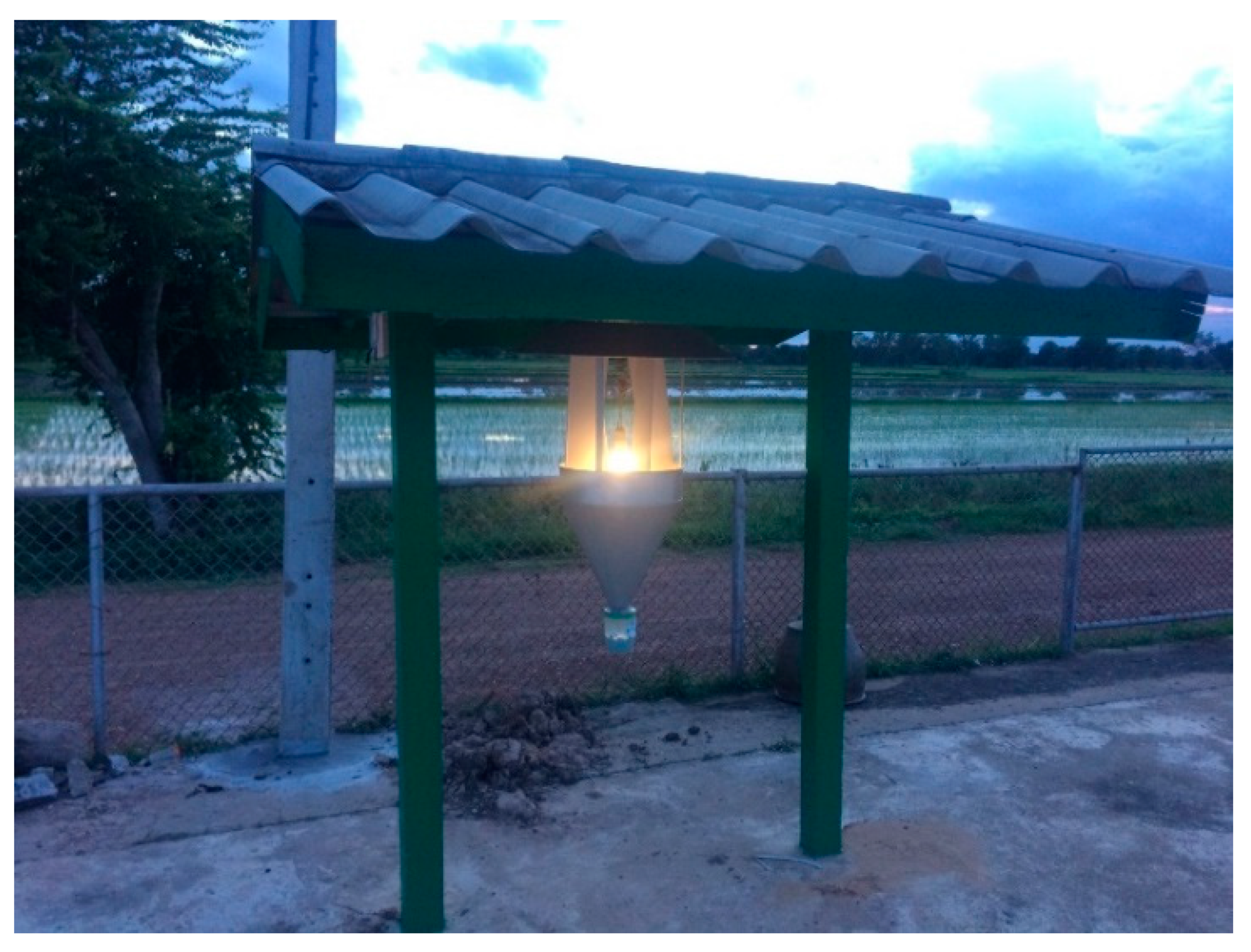

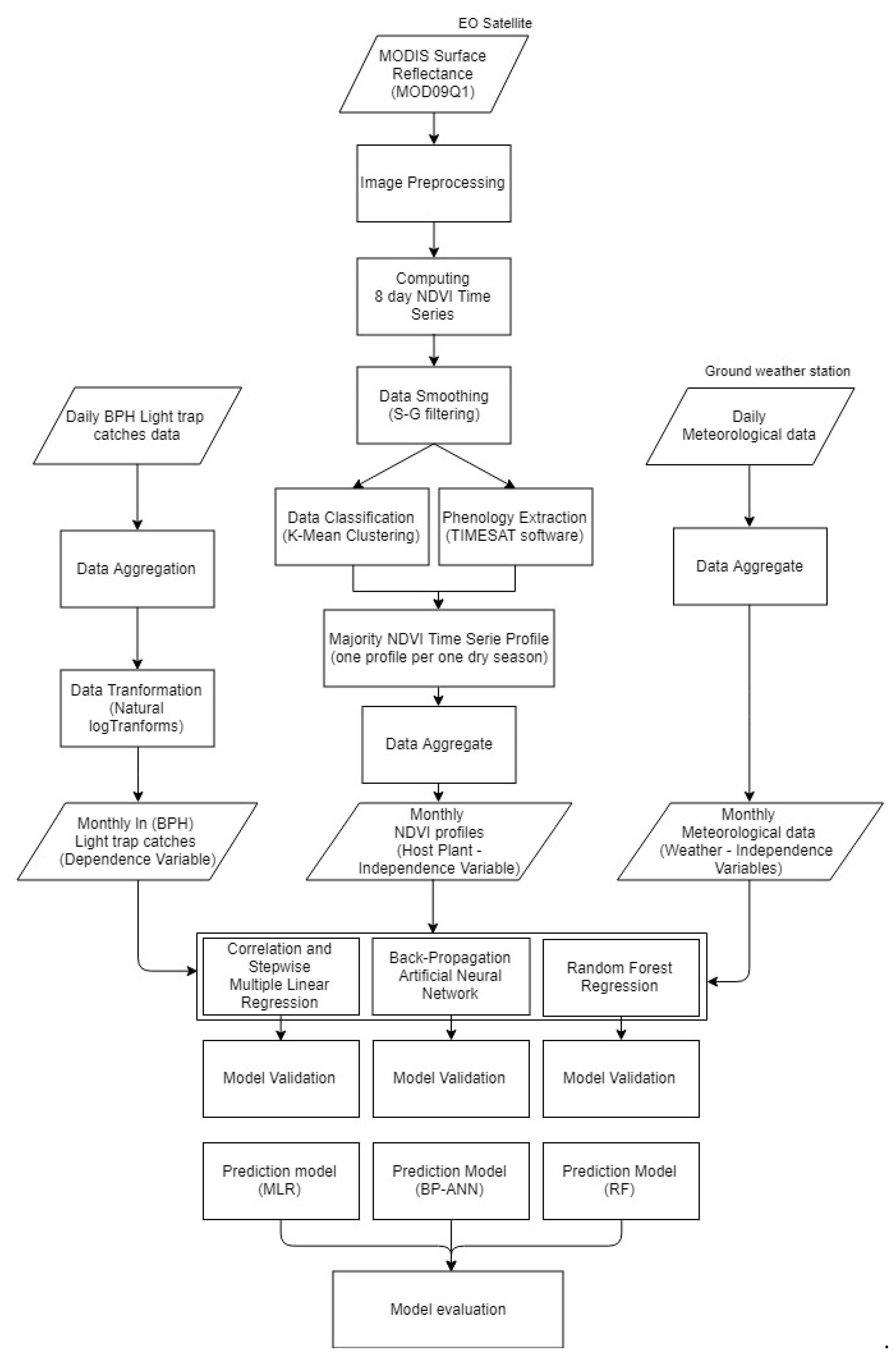
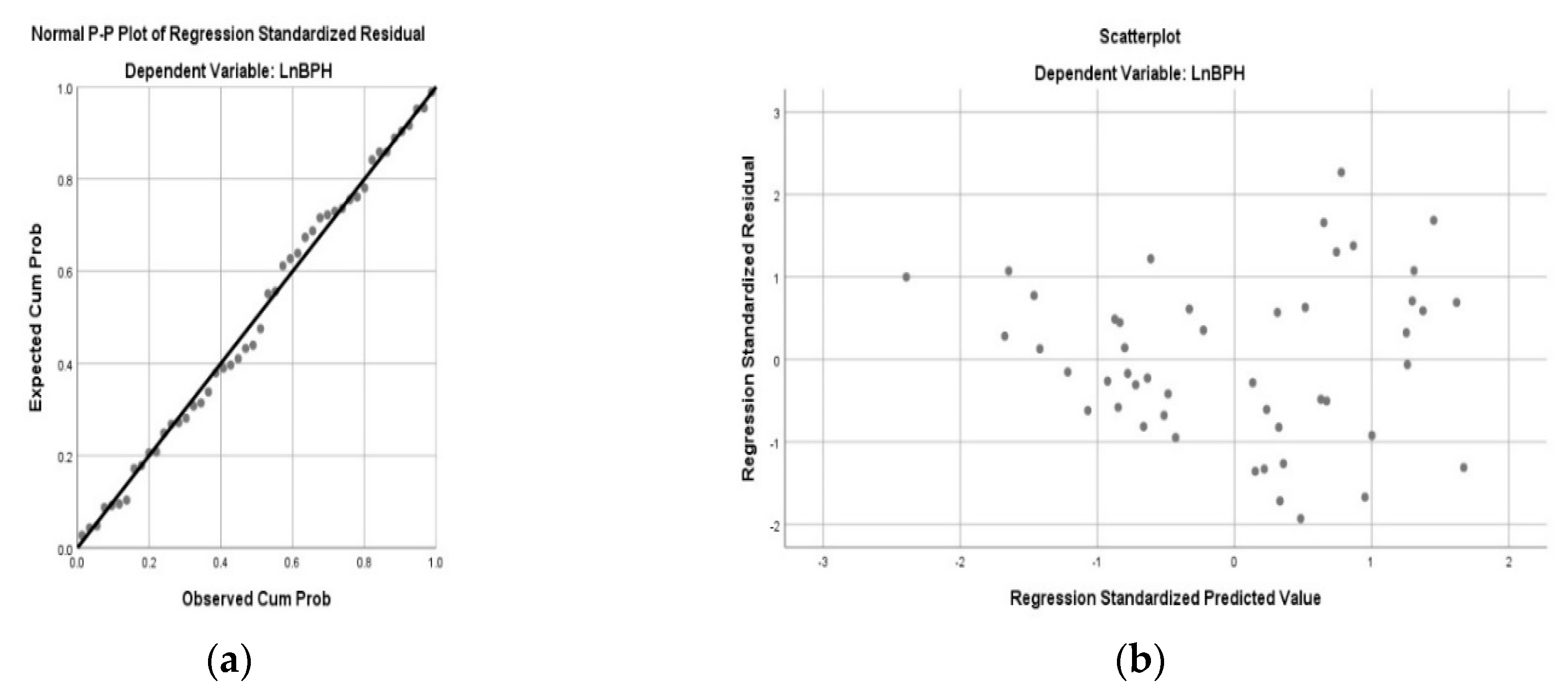

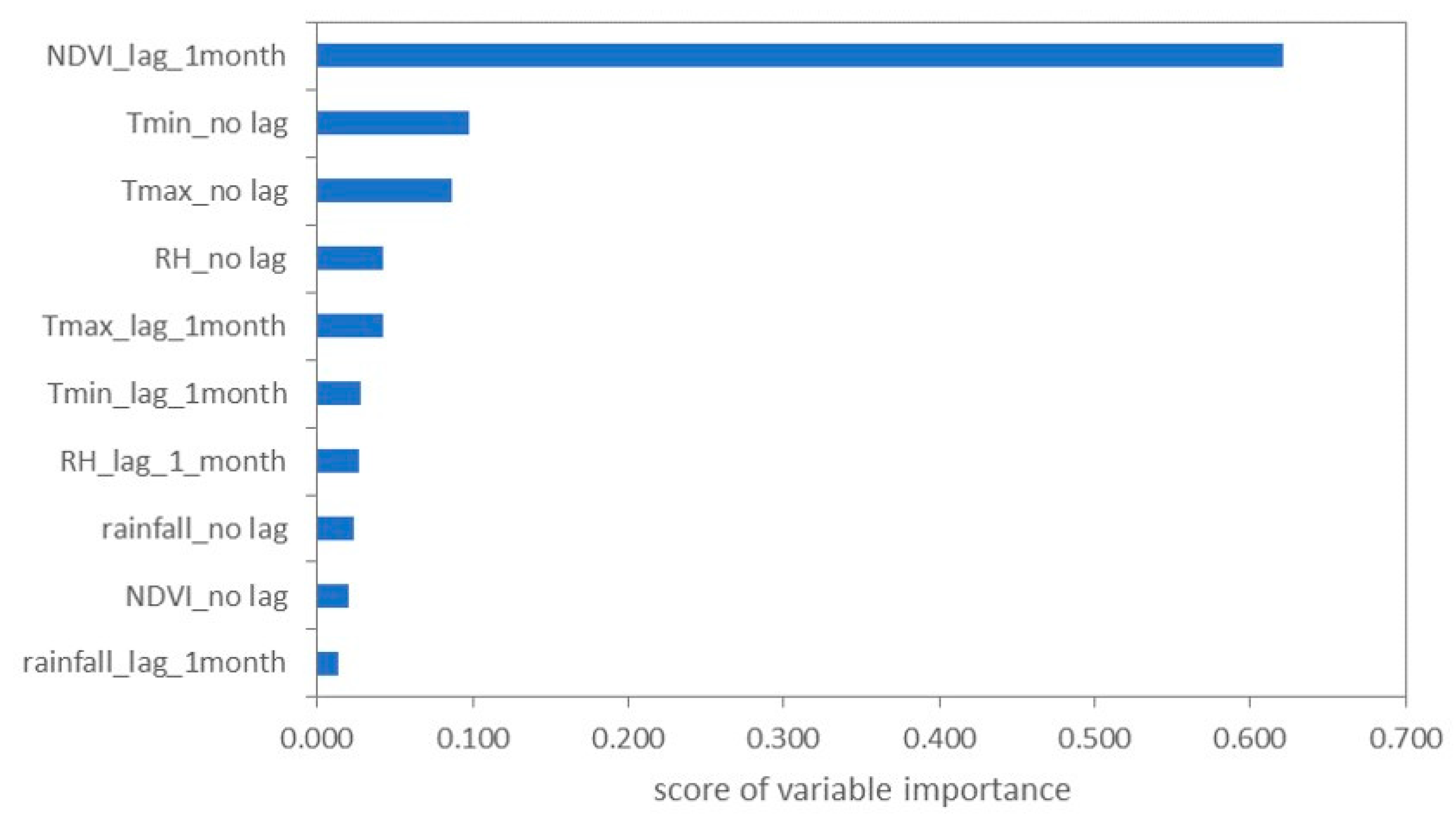
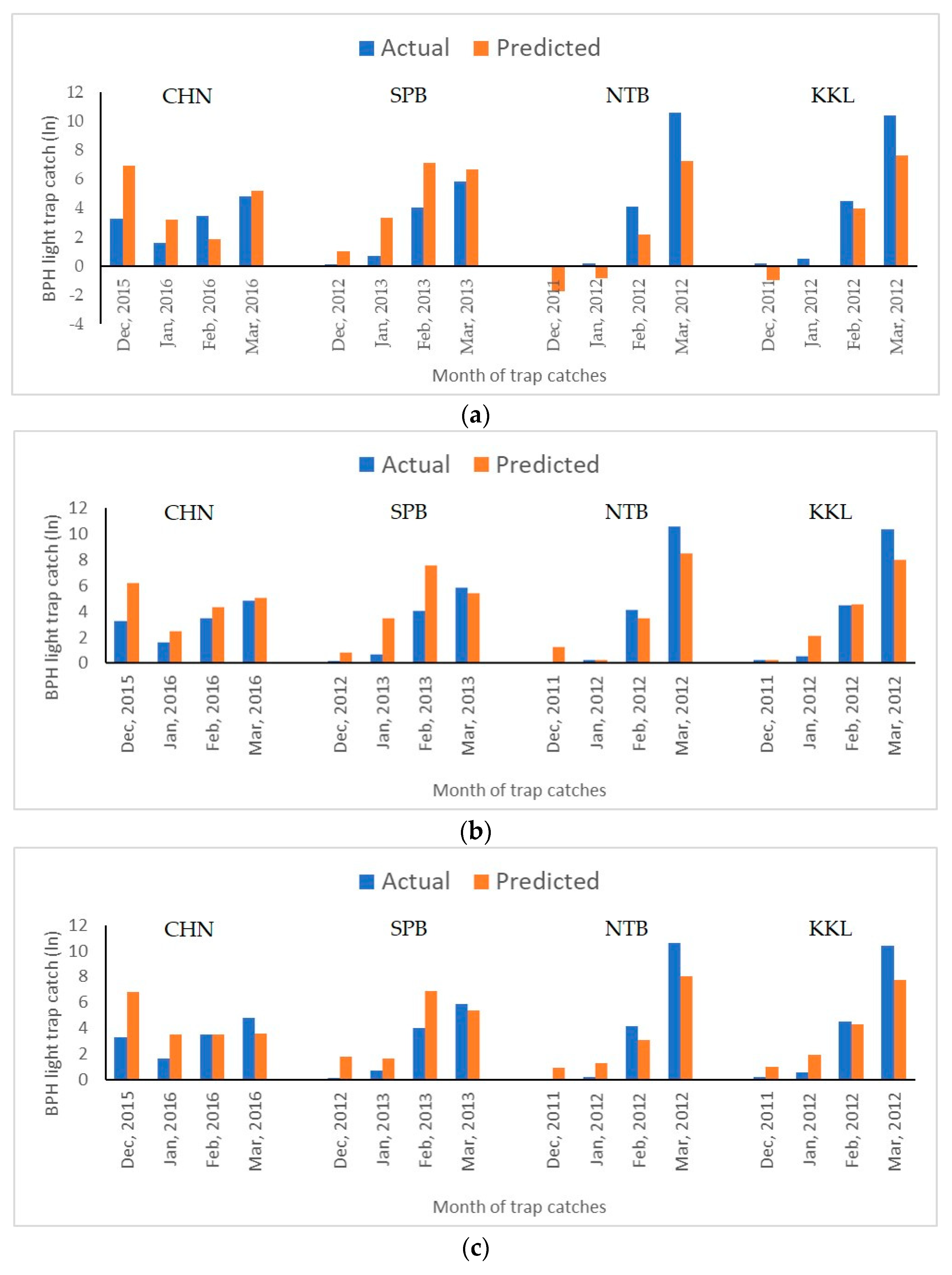
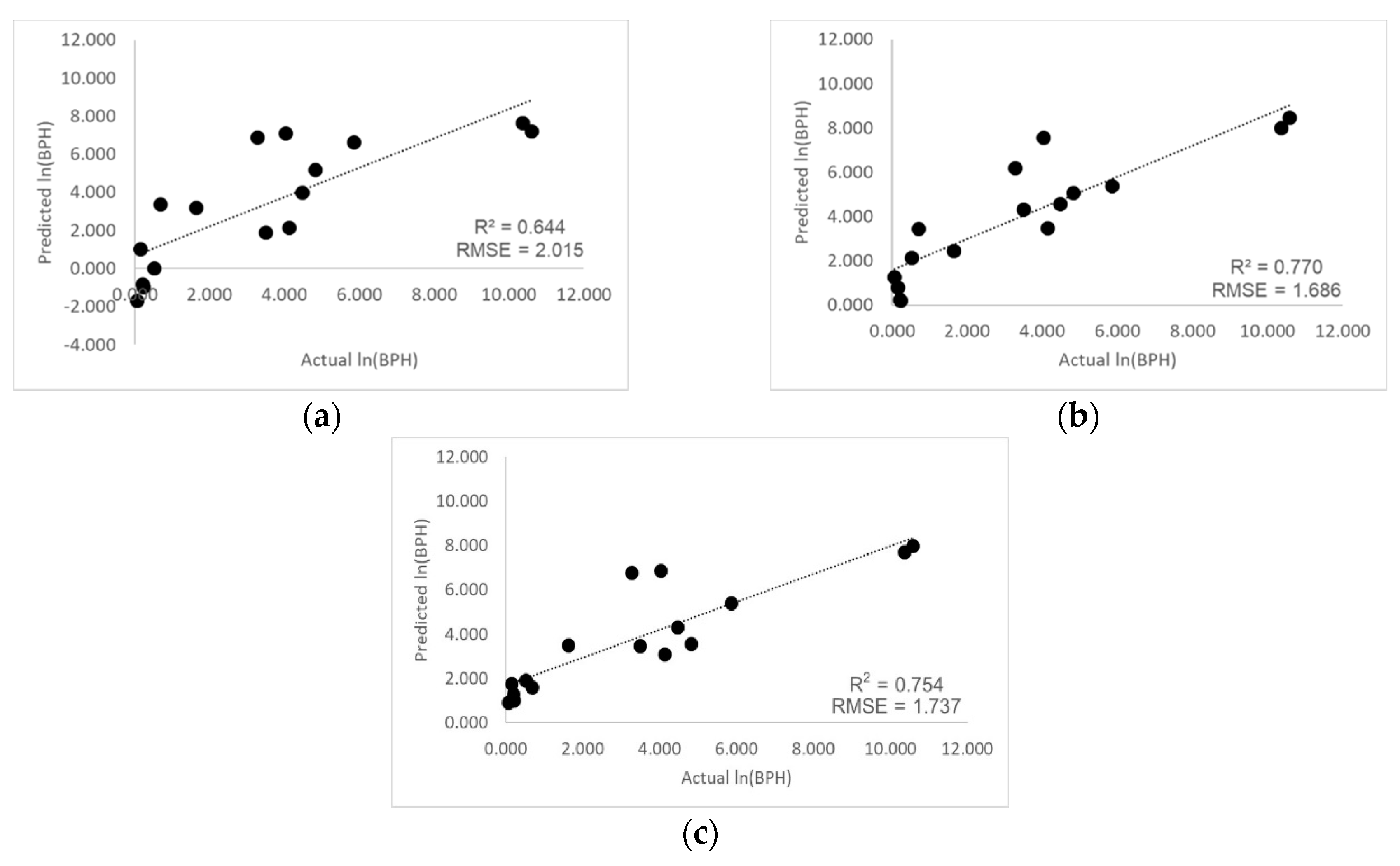
| Site | Place | Input Variables | Output Variable | Month | Rice Crop Season | Training/Testing Data |
|---|---|---|---|---|---|---|
| A | Chai Nat Rice Research Center (CHN) | Tmin, Tmax, RH, rainfall and NDVI at lag 0 and 1 month | Ln (BPH) | December to March | From 2006/2007 to 2014/2015 | Training |
| 2015/2016 | Testing | |||||
| B | Suphan Buri Rice Research Center (SPB) | 2011/2012 | Training | |||
| 2012/2013 | Testing | |||||
| C | Farmer’s paddy field (NTB) | 2010/2011 | Training | |||
| 2011/2012 | Testing | |||||
| D | Khlong Luang Rice Research Center (KKL) | 2010/2011 | Training | |||
| 2011/2012 | Testing |
| Parameters | |
|---|---|
| Number of inputs variables | 10 variables (Tmin, Tmax, RH, RF and NDVI at 0 and 1-previous-month) |
| Number of hidden layers | 1 layer |
| Number of neuron node in hidden layers | 5 nodes |
| Number of output layers | 1 layer (natural log-transformed BPH light trap catches) |
| Learning rate | 0.1, 0.2, 0.3, 0.4, 0.5, 0.6, 0.7, 0.8 and 0.9 |
| Momentum | 0.1, 0.2, 0.3, 0.4, 0.5, 0.6, 0.7, 0.8 and 0.9 |
| Number of training epochs | 500, 1000, 5000 and 10,000 |
| Predictor Variables | Correlation Coefficient (R) | Sig. |
|---|---|---|
| Tmin at lag 0 month | 0.608 | 0.000 ** |
| Tmin at lag 1 month | 0.147 | 0.318 |
| Tmax at lag 0 month | 0.546 | 0.000 ** |
| Tmax at lag 1 month | 0.457 | 0.001 ** |
| RH at lag 0 month | 0.227 | 0.121 |
| RH at lag 1 month | 0.230 | 0.115 |
| RF at lag 0 month | 0.284 | 0.050 |
| RF at lag 1 month | 0.059 | 0.691 |
| NDVI at lag 0 month | 0.183 | 0.213 |
| NDVI at lag 1 month | 0.738 | 0.000 ** |
| Model | Variables | Beta | Std. Beta | t value | p Value | VIF |
|---|---|---|---|---|---|---|
| (1) Weather | (constant) | −15.879 | −4.120 | 0.000 | ||
| Tmin at lag 0 month | 0.909 | 0.608 | 5.192 | 0.000 | 1.000 | |
| N = 48 R2 = 0.369 Adjusted R2 = 0.356 SEE = 2.447 | ||||||
| (2) Weather and Host Plant | (constant) | −11.470 | −3.573 | 0.001 | ||
| Tmin at lag 0 month | 0.432 | 0.289 | 2.564 | 0.014 | 1.436 | |
| NDVI at lag 1 month | 10.512 | 0.579 | 5.140 | 0.000 | 1.436 | |
| N = 48, R2 = 0.603, adjusted R2 = 0.585, SEE = 1.964, Durbin–Watson = 2.016 | ||||||
| Parameters | Value |
|---|---|
| Number of input layers | 10 |
| Number of hidden layers | 1 |
| Number of neuron node in hidden layers | 5 |
| Number of output layers | 1 |
| Learning rate | 0.4 |
| Momentum | 0.5 |
| Number of iterations | 1000 |
© 2019 by the authors. Licensee MDPI, Basel, Switzerland. This article is an open access article distributed under the terms and conditions of the Creative Commons Attribution (CC BY) license (http://creativecommons.org/licenses/by/4.0/).
Share and Cite
Skawsang, S.; Nagai, M.; K. Tripathi, N.; Soni, P. Predicting Rice Pest Population Occurrence with Satellite-Derived Crop Phenology, Ground Meteorological Observation, and Machine Learning: A Case Study for the Central Plain of Thailand. Appl. Sci. 2019, 9, 4846. https://doi.org/10.3390/app9224846
Skawsang S, Nagai M, K. Tripathi N, Soni P. Predicting Rice Pest Population Occurrence with Satellite-Derived Crop Phenology, Ground Meteorological Observation, and Machine Learning: A Case Study for the Central Plain of Thailand. Applied Sciences. 2019; 9(22):4846. https://doi.org/10.3390/app9224846
Chicago/Turabian StyleSkawsang, Sukij, Masahiko Nagai, Nitin K. Tripathi, and Peeyush Soni. 2019. "Predicting Rice Pest Population Occurrence with Satellite-Derived Crop Phenology, Ground Meteorological Observation, and Machine Learning: A Case Study for the Central Plain of Thailand" Applied Sciences 9, no. 22: 4846. https://doi.org/10.3390/app9224846
APA StyleSkawsang, S., Nagai, M., K. Tripathi, N., & Soni, P. (2019). Predicting Rice Pest Population Occurrence with Satellite-Derived Crop Phenology, Ground Meteorological Observation, and Machine Learning: A Case Study for the Central Plain of Thailand. Applied Sciences, 9(22), 4846. https://doi.org/10.3390/app9224846






